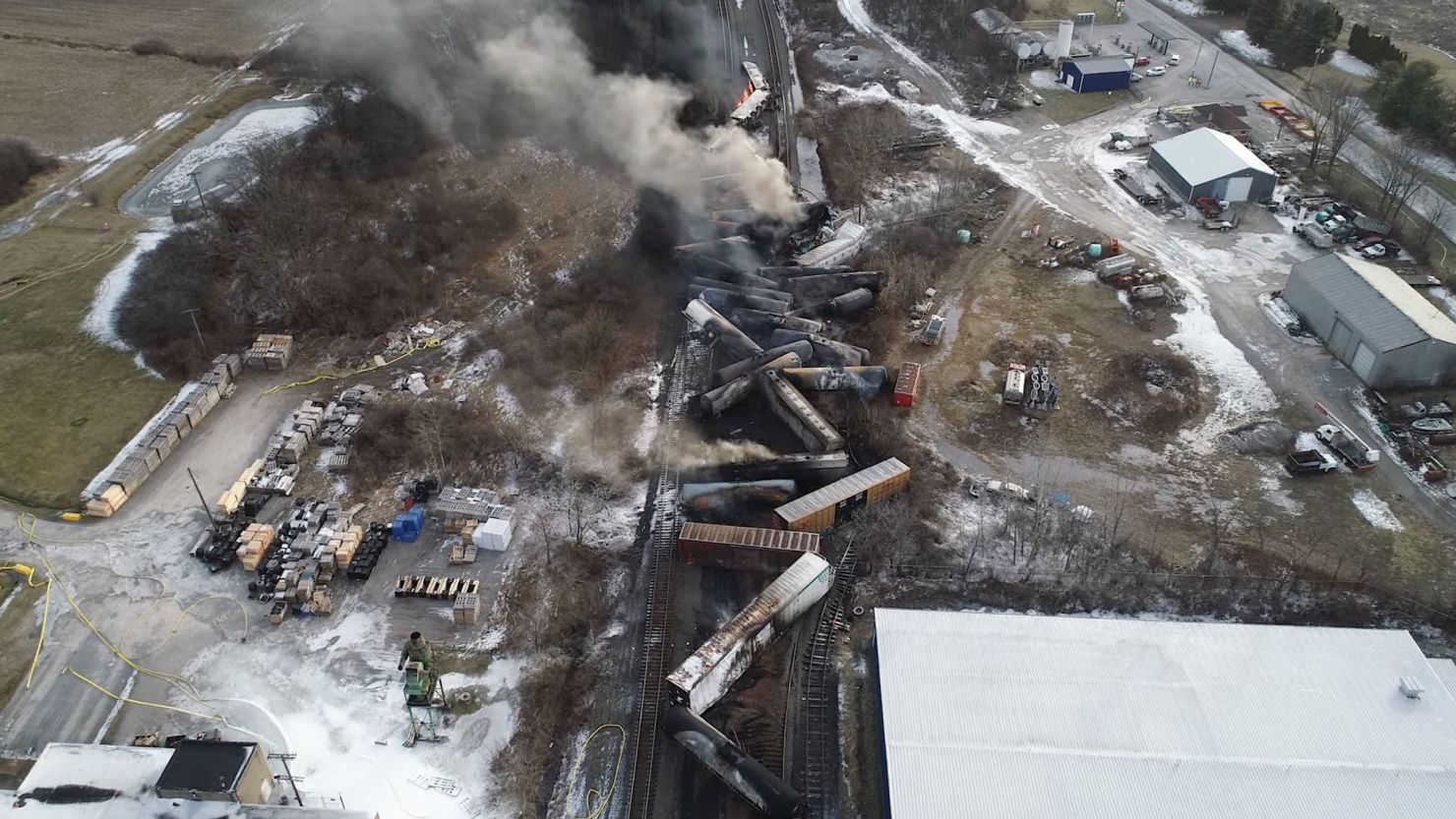Toxic Chemicals From Ohio Train Derailment: Months-Long Building Contamination

Table of Contents
The Scope of the Chemical Spill and its Impact on Buildings
The derailment released a cocktail of hazardous substances, including vinyl chloride, butyl acrylate, and ethylene glycol monobutyl ether, all known for their toxic properties. The impact on nearby buildings is far-reaching and continues to unfold.
Types of Toxic Chemicals Released
- Vinyl Chloride: A colorless gas used in the production of PVC plastics. Exposure can cause liver damage, respiratory problems, and an increased risk of liver cancer. Vinyl chloride is volatile and can easily penetrate building materials.
- Butyl Acrylate: A colorless liquid used in paints, adhesives, and coatings. It can cause skin and eye irritation, respiratory problems, and potential long-term health issues. Butyl acrylate can be absorbed into porous building materials like wood and drywall.
- Ethylene Glycol Monobutyl Ether (EGMBE): A colorless liquid used as a solvent. Exposure can lead to kidney and liver damage, central nervous system depression, and reproductive harm. EGMBE can leach into groundwater and contaminate drinking water supplies.
The widespread nature of the chemical plume makes identifying all affected buildings a significant challenge. The sheer volume of chemicals released and the unpredictable patterns of dispersion mean that contamination may extend far beyond the immediate vicinity of the derailment site.
Pathways of Building Contamination
The toxic chemicals infiltrated buildings through several pathways:
- Air Infiltration: Volatile organic compounds (VOCs) like vinyl chloride readily dispersed through the air, penetrating homes and businesses. These chemicals can persist in the air and be absorbed into building materials.
- Water Contamination: Chemicals leached into the soil and groundwater, potentially contaminating wells and impacting indoor water supplies. This contamination can lead to long-term exposure through drinking water and contact with contaminated surfaces.
- Direct Contact: Individuals may have had direct contact with contaminated soil or water during the initial response and cleanup efforts, leading to immediate and long-term health consequences.
The persistence of these chemicals in different building materials is a significant concern. Some chemicals can bind to porous materials like wood and drywall, leading to prolonged release and exposure. This makes thorough remediation extremely difficult.
Long-Term Health Effects of Exposure to Contaminated Buildings
Exposure to the toxic chemicals released during the Ohio train derailment poses significant acute and chronic health risks.
Acute and Chronic Health Risks
- Acute Health Risks: Immediate health effects include respiratory problems (coughing, shortness of breath, wheezing), skin irritation, eye irritation, and nausea.
- Chronic Health Risks: Long-term exposure to these chemicals is linked to a wide range of serious health problems:
- Cancer: Vinyl chloride is a known carcinogen, increasing the risk of several types of cancer, including liver cancer.
- Reproductive Issues: Exposure to some chemicals can negatively impact reproductive health, leading to infertility and birth defects.
- Neurological Damage: Some chemicals can cause damage to the nervous system, leading to cognitive impairment, neurological disorders, and other neurological problems.
The potential for synergistic effects, where the combined impact of multiple chemicals is greater than the sum of their individual effects, is also a significant concern. The complex mixture of chemicals released makes it difficult to predict the full extent of the health consequences.
Vulnerable Populations
Certain populations are particularly vulnerable to the harmful effects of chemical exposure:
- Children: Children are more susceptible to the harmful effects of toxins due to their developing organ systems and higher rates of respiration.
- Pregnant Women: Exposure during pregnancy can have severe consequences for both the mother and the developing fetus.
- Elderly Individuals: Older adults often have pre-existing health conditions that make them more vulnerable to the effects of chemical exposure.
- Individuals with Pre-existing Conditions: Those with respiratory or cardiovascular disease are at increased risk of severe health problems from exposure to air pollutants.
Comprehensive health monitoring of residents in the affected areas is crucial to assess the long-term health impacts and provide necessary medical support.
Ongoing Cleanup Efforts and Government Response
The cleanup efforts following the Ohio train derailment face considerable challenges.
Challenges in Remediation
- Widespread Contamination: The extensive nature of the chemical spill makes comprehensive cleanup a massive undertaking, requiring substantial resources and time.
- Complex Chemical Interactions: The complex mixture of chemicals necessitates specialized remediation techniques, which may not always be readily available or effective.
- Lack of Technology: For some of the more persistent contaminants, effective removal technologies may be limited or lacking.
Removing chemicals from various building materials presents unique difficulties. Decontaminating soil and water requires different approaches than cleaning porous building materials, making the process lengthy and intricate. The long-term implications of incomplete or inadequate cleanup are significant.
Accountability and Legal Ramifications
The legal ramifications of the derailment are still unfolding. Norfolk Southern, the railway company responsible for the train, faces numerous lawsuits and investigations. The government's response, including the Environmental Protection Agency (EPA) and other agencies, has been subject to scrutiny, raising concerns about the effectiveness and transparency of the cleanup and health monitoring efforts. The allocation of responsibility and compensation for affected individuals and communities remains a crucial aspect of the ongoing debate.
Conclusion
The Ohio train derailment has resulted in a prolonged and severe case of building contamination, posing significant long-term health risks to communities. The complexity of cleanup efforts and the uncertainty surrounding long-term health impacts necessitate a comprehensive and sustained response. Addressing the issues of accountability and providing adequate compensation to affected residents are crucial. The long-term consequences of this environmental disaster underscore the need for stricter regulations and improved safety measures in the transportation of hazardous materials.
Call to Action: Stay informed about the ongoing developments in the Ohio train derailment and the long-term effects of building contamination. Demand transparency and accountability from government agencies and Norfolk Southern to ensure a thorough cleanup and support for affected communities. Learn more about the ongoing health risks associated with exposure to toxic chemicals from the Ohio train derailment and take steps to protect your family and community. Advocate for stricter regulations and improved safety protocols to prevent future environmental disasters.

Featured Posts
-
 Ryujinx Emulator Shuts Down Following Nintendo Contact
Apr 22, 2025
Ryujinx Emulator Shuts Down Following Nintendo Contact
Apr 22, 2025 -
 Fsus Decision To Resume Classes Following Deadly Shooting Too Soon
Apr 22, 2025
Fsus Decision To Resume Classes Following Deadly Shooting Too Soon
Apr 22, 2025 -
 Federal Trade Commission Launches Investigation Into Open Ai And Chat Gpt
Apr 22, 2025
Federal Trade Commission Launches Investigation Into Open Ai And Chat Gpt
Apr 22, 2025 -
 The Future Of Nordic Defense The Pan Nordic Military Strategy
Apr 22, 2025
The Future Of Nordic Defense The Pan Nordic Military Strategy
Apr 22, 2025 -
 Over The Counter Birth Control Implications For Reproductive Healthcare After Roe V Wade
Apr 22, 2025
Over The Counter Birth Control Implications For Reproductive Healthcare After Roe V Wade
Apr 22, 2025
